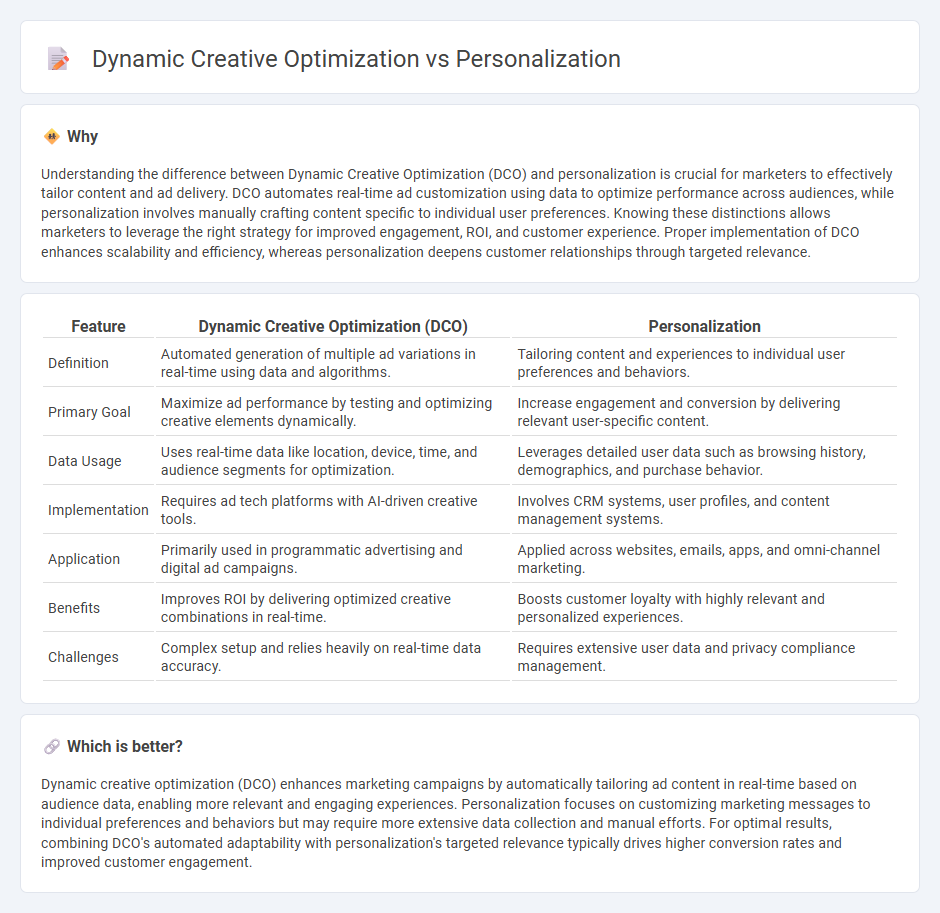
Dynamic creative optimization leverages real-time data to automatically tailor ad content for individual users, enhancing engagement by adapting visuals, messages, and offers based on user behavior and preferences. Personalization focuses on customizing marketing efforts by segmenting audiences and delivering relevant content specific to predefined user profiles. Explore the advantages and applications of both strategies to boost your marketing effectiveness.
Why it is important
Understanding the difference between Dynamic Creative Optimization (DCO) and personalization is crucial for marketers to effectively tailor content and ad delivery. DCO automates real-time ad customization using data to optimize performance across audiences, while personalization involves manually crafting content specific to individual user preferences. Knowing these distinctions allows marketers to leverage the right strategy for improved engagement, ROI, and customer experience. Proper implementation of DCO enhances scalability and efficiency, whereas personalization deepens customer relationships through targeted relevance.
Comparison Table
| Feature | Dynamic Creative Optimization (DCO) | Personalization |
|---|---|---|
| Definition | Automated generation of multiple ad variations in real-time using data and algorithms. | Tailoring content and experiences to individual user preferences and behaviors. |
| Primary Goal | Maximize ad performance by testing and optimizing creative elements dynamically. | Increase engagement and conversion by delivering relevant user-specific content. |
| Data Usage | Uses real-time data like location, device, time, and audience segments for optimization. | Leverages detailed user data such as browsing history, demographics, and purchase behavior. |
| Implementation | Requires ad tech platforms with AI-driven creative tools. | Involves CRM systems, user profiles, and content management systems. |
| Application | Primarily used in programmatic advertising and digital ad campaigns. | Applied across websites, emails, apps, and omni-channel marketing. |
| Benefits | Improves ROI by delivering optimized creative combinations in real-time. | Boosts customer loyalty with highly relevant and personalized experiences. |
| Challenges | Complex setup and relies heavily on real-time data accuracy. | Requires extensive user data and privacy compliance management. |
Which is better?
Dynamic creative optimization (DCO) enhances marketing campaigns by automatically tailoring ad content in real-time based on audience data, enabling more relevant and engaging experiences. Personalization focuses on customizing marketing messages to individual preferences and behaviors but may require more extensive data collection and manual efforts. For optimal results, combining DCO's automated adaptability with personalization's targeted relevance typically drives higher conversion rates and improved customer engagement.
Connection
Dynamic creative optimization (DCO) leverages real-time data to tailor ad content, enhancing personalization by delivering highly relevant messages to individual users. This technology integrates user behavior, demographics, and context to dynamically adjust visuals, copy, and offers, boosting engagement and conversion rates. Personalization through DCO ensures that marketing campaigns resonate more effectively with target audiences, maximizing ROI and customer satisfaction.
Key Terms
Audience Segmentation
Personalization leverages detailed audience segmentation by tailoring content to individual preferences, demographics, and behavior patterns, enhancing relevance and engagement. Dynamic Creative Optimization (DCO) automates the creation of multiple ad variations, serving the most effective version based on real-time audience data and performance metrics. Explore how advanced audience segmentation techniques can optimize marketing strategies through personalization and DCO.
Real-Time Data
Personalization leverages real-time data to tailor content based on individual user behaviors and preferences, enhancing customer experience through targeted messaging. Dynamic Creative Optimization (DCO) uses real-time data algorithms to automatically assemble and deliver the most effective ad variations, optimizing performance across multiple audience segments. Discover how integrating real-time data in personalization and DCO can maximize engagement and conversion rates.
Content Variation
Personalization tailors content based on individual user data such as demographics, behavior, and preferences, delivering highly relevant messages. Dynamic Creative Optimization (DCO) automates the creation of multiple ad variations by continuously testing and optimizing content elements like images, headlines, and calls-to-action in real-time. Explore how leveraging content variation through these techniques can significantly enhance engagement and conversion rates.
Source and External Links
Personalization 101: What it is, importance, and examples - Personalization in business is using known customer data to tailor experiences across marketing, sales, and support by leveraging centralized customer data and protecting privacy to enhance interaction quality.
What is Personalization and How to Get Started - Personalization is continuously optimizing customer experience by delivering the right content to the right person at the right time and channel, aiming for natural, relevant interactions without requiring customer action.
What Is Personalization? Personalization Definition and ... - Personalization tailors products or services to individual needs using customer data and predictive technologies, distinct from customization where the customer actively modifies their experience.
 dowidth.com
dowidth.com